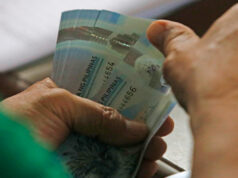Record-high 94% happy with life — SWS
A RECORD-HIGH 94% of adult Filipinos said they are “very/fairly happy” with life in general, with 57% of them very happy, and 37% fairly happy, according to the latest survey by the Social Weather Stations (SWS).
 The Fourth Quarter 2017 Social Weather Survey, fielded over December 8-16 last year, also found a record-high 92% “very/fairly satisfied” with the lives they lead, with 56% of them “very satisfied,” and 37% “fairly satisfied.”
The Fourth Quarter 2017 Social Weather Survey, fielded over December 8-16 last year, also found a record-high 92% “very/fairly satisfied” with the lives they lead, with 56% of them “very satisfied,” and 37% “fairly satisfied.”
Happiness with life, according to the December 2017 survey, is 4 points above the 90% “very/fairly happy” in September 2017, and 3 points above the previous record of 92% in June 1996.
SWS also noted that the 57% who rated themselves as “very happy” was also a record-high that surpassed the previous record of 46% in December 2016.
“Of the 32 surveys since 1991, there have only been five instances wherein over 90% said they were very/fairly happy: June 1996, March 2015, December 2016, September 2017, and December 2017,” the survey said. yet it also noted that “Happiness…has always been high, starting at 85% (correctly rounded) when SWS first surveyed it in July 1991.”
Also a record-high was the 92% respondents “very/fairly satisfied” with the lives they lead.
SWS said this is 4 points above the September 2017 score of 88% and 2 points above the previous record of 90% in September 2016.
The polling group pointed out that satisfaction with life has been scoring at the upper 80s since late 2014, whereas it used to be less than 70% from May 2002 to December 2008, except when it was 75% in June 2003, 77% in June 2004, and 74% in August 2004.
UNHAPPINESS IN NCR
The survey found that at least 9 out of 10 in all areas were happy, with the highest in Mindanao at 96%, followed by Balance Luzon at 95%, the Visayas at 94%, and Metro Manila at 90%.
Unhappiness, on the other hand, was highest in Metro Manila at 10%, followed by the Visayas at 6%, Balance Luzon at 5% and Mindanao at 4%.
By class, happiness was highest in class D, or the masa, at 95%, followed by class ABC at 93%, and class E at 90%. On the other hand, unhappiness was highest in class E at 10%, followed by class ABC at 7%, and class D at 5%.
The survey noted that happiness was slightly higher among those who had more formal education. It was 97% among high school graduates, and 94% among college graduates, compared to 92% among elementary graduates, and 90% among non-elementary graduates.
On the other hand, unhappiness was highest among non-elementary graduates at 10%, followed by elementary graduates at 8%, college graduates at 6%, and high school graduates at 3%.
Happiness was high regardless of religion: 94% among Catholicism and Iglesia ni Cristo members, 93% among Muslims, and 93% among members of other Christian denominations. Unhappiness hardly varied by religion, ranging from 6% to 7%, the survey said.
FORMAL EDUCATION
At least 9 out of 10 in all areas were satisfied with life, with the highest Balance Luzon at 94%, followed by Metro Manila at 93%, Mindanao at 91%, and the Visayas at 89%. Dissatisfaction with life, on the other hand, was highest in the Visayas at 11%, followed by Mindanao at 9%, Metro Manila at 7%, and Balance Luzon at 6%.
By class, satisfaction with life was highest in class D at 93%, followed closely by class ABC at 92%, and class E at 89%. Conversely, dissatisfaction with life was highest in class E at 11%, followed by class ABC at 8%, and class D at 7%.
As with happiness, satisfaction with life was higher among those with more formal education. It was highest among college graduates at 94% and high school graduates at 94%, followed by elementary graduates at 91%, and non-elementary graduates at 90%.
On the other hand, dissatisfaction with life was highest among non-elementary graduates at 10%, followed by elementary graduates at 9%, high school graduates at 6%, and college graduates at 6%.
Satisfaction with life was equally high across religions: 96% among Muslims, 94% among the Iglesia ni Cristo, 92% among Catholics, and 90% among other Christians. Dissatisfaction with life also did not vary by religion, ranging from 6% to 7%.
The noncommissioned survey was conducted using face-to-face interviews of 1,200 adults nationwide, with 300 each in Metro Manila, Balance Luzon, the Visayas, and Mindanao, and sampling error margins of ±3% for national percentages, and ±6% each for those cited areas.



